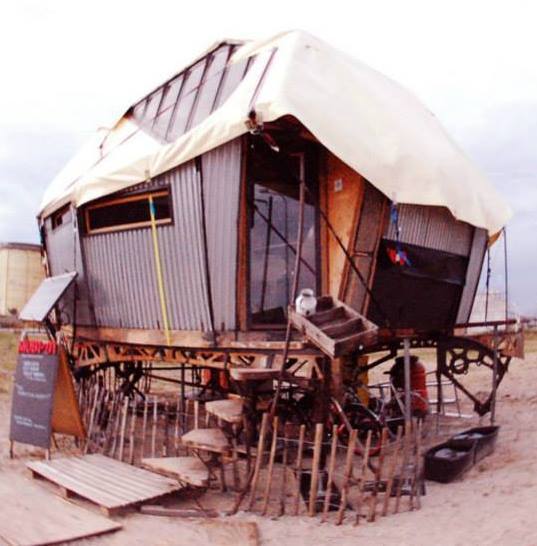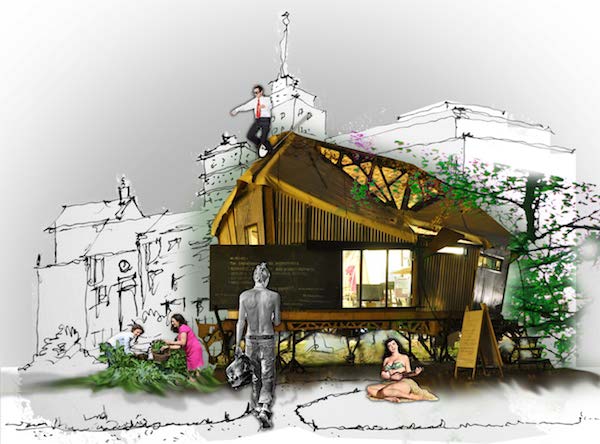by Calanne Moroney
The Mobiation Project – a tiny house project with a difference
Since August 2012, we have been living in the mobi-01, a mobile off-grid, open-house that has been moving around Amsterdam, though we are making plans to take it across borders.
Rather than the usual tiny-houses of the movement, this one has a more social role, camping mostly in semi-public urban spots, and folds in to become a 20ft container, when in transport mode.
The tale so far:
“We wanted to go neo-primtive, simple, small and funky. We seemingly have a desire for attention, so the house is open. We do workshops on various DIY techniques, presentations and talks about the project, are filming footage for a documentary about the project, and have been building up a repertoire of message-laden tracks [music] to take the info-tainment just that little bit further. The Mobiation Project was set up to give us meaning, an all-encompassing live project that, because we set up a foundation to manage it, has a goal to spread the word. The house folds into a 20ft container, can then be lifted onto a container truck and transported to the next location.

A small 350W wind turbine and a 160W pv panel supplies the electricity for laptops and LED lighting. Rainwater provides for most of our water needs – we have, at some locations, filtered ditch water, to supplement this. We are currently drawing up the bath/composting toilet trailer that parks into the mobi-01, but for now use a bucket for washing, and a small urine-separating unit for toilet, and a wormery & bokashi bin for kitchen waste.
Till now, we have been urban nomads. Some of the locations have been – a festival [three in total] where we did gigs, film showings, playing open-houses and workshops/talks, and building and managing some composting toilets; an exhibition on “urban outsiders,” where we were a live exhibition piece; a suburban playground where we were an informal meeting place, built willow huts, made fires, read stories to the kids around the stove, built a cob oven, set up a community veg patch and so forth…. Currently we are stationed next to a restaurant in an as of yet undeveloped part of Amsterdam east, where we are assisting the restaurant in greening up their business, as well as working with the first inhabitants of the area to set up a community edible garden…

So far, the approach has been to be invited to come and help on some community project, in return for a place to set up house. This has been in and around Amsterdam, but this year we will be making the move away from Amsterdam. Its time to leave the city and move out into less known territory.
Together, we are ecological architect, welder, furniture maker, compost toilet enthusiasts, vegan-foodie, doglover, DIY-enthusiast, tattooist and graphic designer…. in fact, we are well educated autodidacts and whatever we cannot do, we look it up, call on others to assist and as last resort, work on trial and error. There’s a whole philosophy behind the project about self-determinism, anarchism, anti-individualism and anti-corporate control, and we are exploring and developing this in music, as well as writing a graphic novel set in the future.
Simple living and doing good is the essence of the project, and it appears to be an ongoing process.
We would love to assist people to move along the same path, in return for somewhere to stay, a weekly box of local organic veg and other negotiable treats. We discovered that we are change junkies, conscientious change junkies and like to move into different contexts, inject some good, game-changing energy and action, and move onto the next location. Perhaps some day, we’ll settle somewhere – I have a dream to bury the mobi-01 into a south-facing hillside, but for now, we embrace nomadism and the global awareness it engenders.”
See more at www.mobiation.net


This is the most amazing one yet!! I am sorry that I was not able to link to the website.
The outside looks like a mess…but inside i find it intriguing and want to explore it all almost like a robinson crusoe type dwelling.
There is something in me that finds being a modern gypsy appealing though even they have home bases they travel back to for the winter. Even these folks have a dream of one day finding a fixed location, travel is only fun and endurable when there is a home to go back to…those who have travelled for a long time will know what i mean. I think it’s human nature to wander, but also to have a fixed dwelling or a bit of land to call home.
Modern society doesn’t like anything outside what it considers ‘normal’ and tiny homes or living full time in an RV is outside the norm for most people. It’s there that we encounter troubles with codes and communities trying to protect their status quo.
European nomads or gypsies have their own communities and for good reason, they are not accepted in traditional communities and this has been so for millennia…again, human nature.
Some are looking into building tiny home communities…and that’s a good thing, historically it’s the only way it has worked. People fear change, the mysterious outsiders are feared because they live a different lifestyle. Understanding a people in theory is one thing, reality is different and though we may be understood we will never be accepted into traditional communities because we don’t have the same goals, we don’t like what they like, and they will find that threatening eventually.
John,
Realistically thinking, we probably will stay somewhere longer in the future. Not knowing where that would be, we started on the structure, and so stumbled into a nomadic lifestyle.
I agree on the need for roots being a seemingly elemental part of human nature, but I do believe that being rooted in a theory, or a lifestyle, and the global community that this opens up, satisfies much of this need and that perhaps fixing oneself to a place is not necessarily the solution. Nomadism is not an essential part of this project, though it has created very intriguing scenarios to date, and eventually may give way, should we find ourselves somewhere that we feel we can achieve more by staying longer.
My God, that is ugly. Would it have been any more expensive to design or build something that was not such an eyesore?
Aesthetics are important to humans and most people don’t want to live in a place others might label a “hovel”. If one looks this bad just think what a collection of them will look like. The concept itself is great, but even yurts would look nicer—and I find them (specifically the outside sheeting) pretty ugly.
Certainly a throw back to A guide to the Woodbutcher’s Art in the 70s by Art Boericke. Can’t figure out if this isn’t just a big joke on the tiny house movement. I did get a big laugh out of it.
“The works of Ant Farm, the situationists, Superstudio and the likes of Archigram are even more relevant today.” ~ From their blog.
The similarities to the 70’s movements are (somewhat) intentional.
The mini-house is highly evolving. I watch this development closely — it is the wave of the future. The whole world is going through a social revolution for the better.
We here at Corona Farm, in the far NW corner of continental U.S., like the house, the design, especially the interior, and the practicality of it folding up and moving! Would make great farm housing for young person or couple. (We have a place here for one!) Wouldn’t want 10 of them, but then, I wouldn’t want 10 of anything. GreenwayRG@gmail.com
While I applaud people who follow their own path, I feel sad looking at this structure. I wish for greater acceptance of tiny houses in general; for a future that includes legal, safe parking/building sites in urban areas so they needn’t simply be relegated to places too far out in the boonies for neighbors/zoning enforcement to care. And regretfully, I feel an eyesore-inducing hodgepodge mess like this deeply undermines that goal. On the plus side, Amsterdam is an accepting city (with some modern architecture that actually shares this same slapdash aesthetic!) but I shudder to think how this would turn off your average American, if their first exposure to the concept of tiny living was seeing this monstrosity squatting in their local park. 🙁
Luckily for us it seems, we’re not planning on coming to the US. The project is about so much more than the supposedly disturbing and offensive aesthetics, and yes, that seems to be understood quicker here in Europe [not just Amsterdam] than in the States.
What is interesting is that the fact that the structure is peculiar and uncategorisable, appears to encourage people to cross the threshold and question its very being there – and so and earnest dialogue can be born. We have encountered many wonderful people and ideas because of this.
I really like it. Yes, it is like something out of Swiss Family Robinson.Beauty is in the eye of the beholder.
Agreed. But it will take most Americans who have been fed sardine symmetry subdivisions for 60+ years a bit longer to process it I suspect 😉
This is chaotic and very ugly. I think the whole thing is intended to make fun of the tiny house movement.
I understand that adolescence brings a period of acceptable chaos but for adults trying to find some alternatives to huge mortgages this project is not constructive, either satirically, aesthetically or even structurally.
Truman,
British Columbia
Hmm. can’t quite figure out what’s going on here..
OUCH!
A picture is worth a thousand words.
These pictures are not worth the many thousands of words that accompany it on the site it anchors.
Too many words used to describe the lifestyles and very little to push the actual structure.
My first impression is a camoflaged crab sticking flotsam and bits to itself as a disguise.
Reminds me of burningman structures.
Pop up tent trailer without the trailer.
This mobi-01 — I can’t quite place it. If I came across it in a park, as it’s apparently been in — I wouldn’t be able to judge it as a tiny house or a wagon or a whatever! As a Tiny Houser myself, I appreciate their efforts…. they seem to be the ambassadors of our values to the rest of the world, and… good for them!
This does have an interesting vibe and beauty is in the eye of the beholder. They were going for funky and made the goal. I’m not sure I would choose this exterior design & implementation – but I like it in a Mad Max kind of way. And yes, this would look right at home on the Playa, wouldn’t it? 🙂
Love the way this looks! I was surprised to read the unacceptance of it’s aesthetics.
The TH movement has changed some in the last few years. Many are now findng it through home decor/design blogs…
(I’ll refrain from telling you what some of us old-timers call them 😉 )
I think it is beautiful, imaginative, with flair and of course energy, life is a constant flow and often brings surprises, and mistakes. It is not be possible to build, something like this where I live, but to see what is happening in other parts of the world, I give thanks as nothing is constant and imagination, always has a past.
.
Well – this kind of mobility was once only reserved for tinkers and wheelchair users. Well done.
i love the concept and execution. very
nice use of transforming a container with simple kinetic geometrie.
would like to see some details of the underlying construction. also the fabric-cover is cool i think, it gives the whole thing this camping touch =)
peace, l.